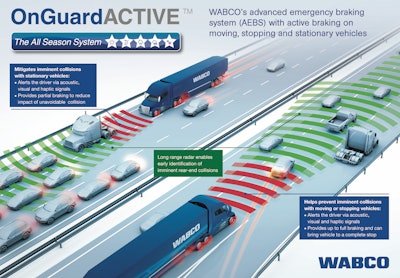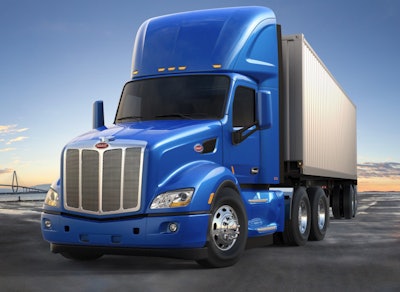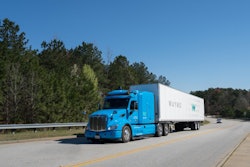Note: This is the second of a three-part series looking at collision mitigation technologies. The first installment, “Collision mitigation take rates on the rise,” can be found here. The next article, “Third party providers playing active role in ADAS development,” will publish Wednesday.
Conditions on the road are anything but easy. Weather events, rough roads, dust storms and even insects can make running down the road less than ideal for a driver. But what about a high-tech collision mitigation system with cameras and various sensors? According to Roy Horton, Mack Truck’s director of product strategy, Bendix Wingman Fusion has been holding up fine.
 Mack relies on Bendix Wingman Fushion which uses both camera and radar technology.
Mack relies on Bendix Wingman Fushion which uses both camera and radar technology.“The fact that the Bendix Wingman Fusion system uses two sensors, the radar sensor in the bumper and the camera in the windshield, enables the system to operate in a variety of weather conditions, since it does not rely on data from one source, but is able to look at input from both sources to control the system,” Horton said.
Wingman Fusion is calibrated at the factory, so there’s no need for an adjustment unless a component is damaged. For instance, the system’s camera is mounted to the windshield and in case the windshield has to be replaced, dealers are provided with calibration instructions.
Bendix recommends during pre-trip inspection to make sure that sensors and cameras are free of any obstructions, such as snow or mud. Lower visibility driving conditions experienced during snow or rain events can also impede the system.
“These are Level 1 driver assistance systems. They’re not magic,” said Richard Buyer, vice-president of engineering and R&D at Bendix. “If you are in a zero-visibility situation, this system will have reduced capability even though the radar part of it can penetrate some of these conditions, but you as a driver should be driving smart. So, if you have low visibility, you should be slowing down. You still shouldn’t be doing 70, 80 miles per hour.”
There are plenty of collision mitigation features on Bendix Wingman Fusion, like forward collision warning, automatic emergency braking, speed sign recognition and adaptive cruise control. And along with the forward collision mitigation systems, there’s also right side blind spot warning and lane departure warning. So which features have fleets liked best?
“Their most favorite part of the system, and the option that we have had the most feedback on, is the adaptive cruise control function,” Horton said. “Being able to drive down the highway at speed, setting the cruise control and the truck keeps pace with the vehicle in front, is a feature truck drivers love.”
Currently, only electronic stability control is required on Class 7 – 8 trucks. Does Mack see a change coming when additional safety technologies will be required?
“We don’t want to speculate on what may or may not be required by law, but we believe advanced driver assistance systems like Bendix Wingman Fusion bring many safety benefits to drivers, which is why we made it standard on our Anthem model,” Horton said.
Navistar notices uptick in collision mitigation
Navistar uses both Bendix and Wabco collision mitigation technologies.
“Wingman Advanced and Wabco OnGaurd ACTIVE use radar to monitor objects in front of the vehicle and are able to apply the vehicle brakes if necessary,” said Steve Gilligan, vice president of product marketing at Navistar. “Bendix Wingman Fusion uses a radar system in conjunction with a camera to provide additional functionality. Bendix BlindSpotter uses radar to provide side object detection, and to alert the driver if an object is detected. Meritor Wabco OnLaneALERT is a lane departure system that warns the operator when unintentional lane drifting is detected.”
 Navistar uses Wabco and Bendix collision mitigation systems.
Navistar uses Wabco and Bendix collision mitigation systems.Fleet adoption rates have been on the rise.
“Fleet adoption has risen significantly in the last two years and is projected to continue,” Gilligan said. “Data indicates that both accident frequency and severity is reduced from the use of collision mitigation systems. The customer need for safer and more intelligent vehicles has driven the requirements of manufacturers to provide those features.”
When it comes to periodic maintenance, such as recalibration, Gilligan said the brake themselves are more of a concern.
“The system itself, does not call out the need for periodic updates to calibrations unless there is a need to realign the sensors,” Gilligan explained. “As with any of these types of systems, they require properly maintained truck foundation brakes (whether S-Cam or air disc) which meet appropriate safety standards and regulations. The performance of the braking system also requires that the vehicle be equipped with properly sized and inflated tires, and with a safe tread depth.”
Gilligan said the trucking industry’s own actions at increasing truck safety features has kept it well ahead of regulatory efforts.
“We work closely with compliance and regulatory teams, customer/trade associations, safety boards, as well as our safety systems provides to ensure that we are anticipating the needs of our owners and operators,” Gilligan said. “The trucking industry is well ahead of any regulatory requirements due to fleets voluntary actions.”
Peterbilt: collision mitigation take-rate is on the rise
Take rates for Bendix Wingman Fusion on Peterbilt trucks have been steadily increasing.
 Peterbilt reports that more customers are specing their trucks with collision mitigation features.
Peterbilt reports that more customers are specing their trucks with collision mitigation features.“Adoption of collision mitigation technologies by our customers in on the rise,” said Peterbilt assistant chief engineer Darryl Oster. “We see over 50 percent of our over-the-road customers using collision mitigation systems today.”
The camera and radar-based system provides more redundancies over prior systems which increases overall effectiveness, including battles with inclement weather.
“There may have been some challenges in the past with snow or ice packing on the radars, but with the newer systems that incorporate both camera and radar technology together functionality has greatly improved in these conditions,” Oster explained.
Periodic maintenance on the ADAS components, such as calibration, is basically nil.
“The only maintenance requirement is recalibrating the camera in the case of a windshield repair,” Oster said. “The cameras are designed to be mounted in the path of the windshield wiper arm so that it is clear in rainy or fogged situations. However, an overly dirty windshield can impact the effectiveness of the camera.”
Does Peterbilt anticipate other ADAS features, such as Automated Emergency Braking (AEB), to be required soon?
“It is anticipated that AEB may be required for some commercial vehicles in the future, but the timeframe for that requirement is unknown,” Oster said. “However, Peterbilt is prepared with the collision mitigation system available from Bendix.”
Volvo, Bendix working together to deploy technology
Volvo Active Driver Assist (VADA) uses radar sensors and cameras to identify and detect objects that pose a threat of collision. Bendix manufacturers the components for VADA.
“The radar sensors detect up to 500 feet, alerting the driver to slow down or stop, while lane departure warning uses the windshield-mounted camera to track road markings,” said Ashraf Makki, product marketing manager of connectivity at Volvo.
“While severe weather, like snow, impacts everything on the road, we’ve made our products durable and are continuing to improve these functionalities in severe weather.”
Some maintenance is recommended. The windshield-mounted camera requires calibration on a three to six month basis, depending on the application of the truck, Makki said.
Volvo expects that other ADAS features, such as AEB, will be mandated before too long.
“Yes, we anticipate that ADAS features will be a requirement among trucks in the near future,” Makki said.
Depending on design, electric vehicles can offer quicker torque vectoring courtesy of direct drive motors which can translate to faster and more precise wheel responses. Though it’s a little early in the game, we asked Volvo if they foresee any advantages in using ADAS components on an electric truck over a conventional vehicle.
“The VADA system will need to be tuned differently to accommodate the VNR Electric and will take additional testing to ensure the software is compatible, meaning the electric control module is able to communicate with the camera and radar sensors,” Makki said.



![Detroit_Assurance_5.0_Full_Braking_Moving_Pedestrian[1]-2019-12-23-11-26](https://img.ccjdigital.com/files/base/randallreilly/all/image/2019/12/ccj.Detroit_Assurance_5.0_Full_Braking_Moving_Pedestrian1-2019-12-23-11-26.png?auto=format%2Ccompress&fit=crop&h=167&q=70&w=250)







